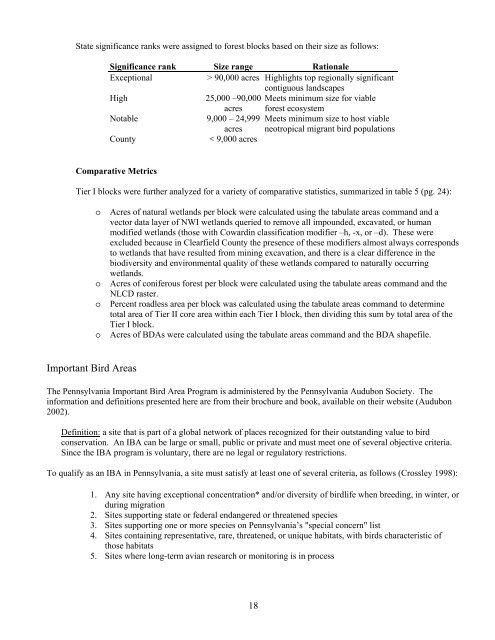introduction - Pennsylvania Natural Heritage Program
introduction - Pennsylvania Natural Heritage Program
introduction - Pennsylvania Natural Heritage Program
Create successful ePaper yourself
Turn your PDF publications into a flip-book with our unique Google optimized e-Paper software.
State significance ranks were assigned to forest blocks based on their size as follows:Significance rank Size range RationaleExceptional> 90,000 acres Highlights top regionally significantcontiguous landscapesHigh 25,000 –90,000 Meets minimum size for viableacres forest ecosystemNotable 9,000 – 24,999 Meets minimum size to host viableacres neotropical migrant bird populationsCounty< 9,000 acresComparative MetricsTier I blocks were further analyzed for a variety of comparative statistics, summarized in table 5 (pg. 24):o Acres of natural wetlands per block were calculated using the tabulate areas command and avector data layer of NWI wetlands queried to remove all impounded, excavated, or humanmodified wetlands (those with Cowardin classification modifier –h, -x, or –d). These wereexcluded because in Clearfield County the presence of these modifiers almost always correspondsto wetlands that have resulted from mining excavation, and there is a clear difference in thebiodiversity and environmental quality of these wetlands compared to naturally occurringwetlands.o Acres of coniferous forest per block were calculated using the tabulate areas command and theNLCD raster.o Percent roadless area per block was calculated using the tabulate areas command to determinetotal area of Tier II core area within each Tier I block, then dividing this sum by total area of theTier I block.o Acres of BDAs were calculated using the tabulate areas command and the BDA shapefile.Important Bird AreasThe <strong>Pennsylvania</strong> Important Bird Area <strong>Program</strong> is administered by the <strong>Pennsylvania</strong> Audubon Society. Theinformation and definitions presented here are from their brochure and book, available on their website (Audubon2002).Definition: a site that is part of a global network of places recognized for their outstanding value to birdconservation. An IBA can be large or small, public or private and must meet one of several objective criteria.Since the IBA program is voluntary, there are no legal or regulatory restrictions.To qualify as an IBA in <strong>Pennsylvania</strong>, a site must satisfy at least one of several criteria, as follows (Crossley 1998):1. Any site having exceptional concentration* and/or diversity of birdlife when breeding, in winter, orduring migration2. Sites supporting state or federal endangered or threatened species3. Sites supporting one or more species on <strong>Pennsylvania</strong>’s "special concern" list4. Sites containing representative, rare, threatened, or unique habitats, with birds characteristic ofthose habitats5. Sites where long-term avian research or monitoring is in process18










